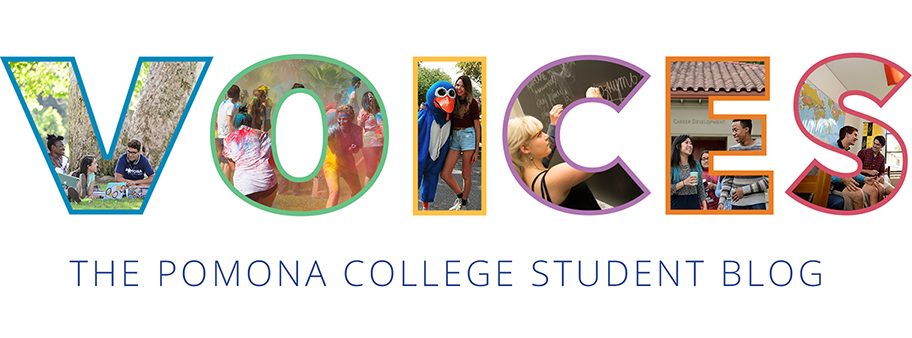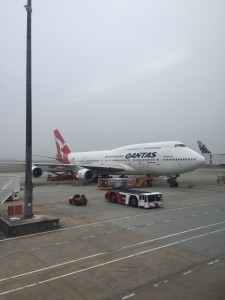Like any good adventure, mine begins and ends with time travel (courtesy of the International Date Line). I left Claremont for Brisbane, a large city in Queensland, Australia, on a Tuesday and arrived on a Thursday after 14 hours of travel. My return flight will reach the United States three hours before it leaves Australia.
The time zone switch was especially difficult on the first day. The flight attendant had woken me up in the middle of the flight to give me dinner, and when I asked her if I could go back to sleep and ask for it later, she said no because then it wouldn’t be as hot as she wanted me to enjoy it. I chose a salad and tried to go back to sleep, but was semi-conscious throughout the rest of the flight, passengers stumbling to the bathroom near me in the dim cabin in dreamlike movements. By the time I arrived to the airport and was hurriedly herded through customs, I was disoriented and ready to sleep. I almost cried when the grad student I’m working with asked if I wanted lunch and I realized it wasn’t dinnertime and he wasn’t kidding. Switching to a field season schedule rather than a sleepy college student schedule made the transition easier, at least: I adjusted to a schedule that has me waking up at 5 am and going to sleep at 9 pm, which feels like adjusting to someplace four timezones closer to Claremont than if I were waking up at 9 am.
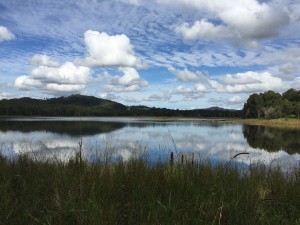
I’m in Australia this summer to do field research with a PhD student from Cornell University. We’re studying social behavior of red-backed fairy-wrens, which means catching, banding, and observing birds in a large plot of land near the Queensland rainforest. (Check out this video or this video of the wrens preening each other, both by the graduate student.) Most of my time is spent at the field site, where I encounter all kinds of flora and fauna and landscapes. Almost all trees on site are eucalyptus, but so many other species are invasive. I have a lot of trouble orienting myself because the world around me has pieces from a lot of other landscapes.
The license plates say “The Sunshine State,” referring to Queensland — although Florida, my home state, is also the Sunshine State. Lantana, which I’ve planted in Miami in a native butterfly garden, has been introduced to Australia and has taken over the field site. The rainforest and mountainous terrain remind me of Hawaii, as do the remarkably colored birds.
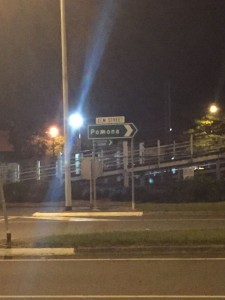
Across the lake from where I work, the savanna landscape with tall trees and acacia look like what I imagine parts of the Serengeti look like. Lady Gaga on the radio and signs for McDonalds take me back to the States, but then driving on the left startles me into realizing I am not in the US, and then a pineapple farm we drive past makes me again think of Hawaii. Oh, and then I pass a sign for a village called Pomona and I get all confused again. I have trouble realizing that I am actually in Australia, even when I obviously don’t speak in the same accent as the locals I encounter.
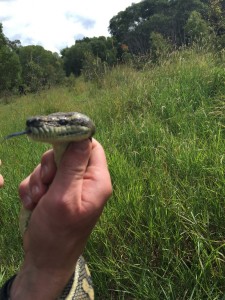
That said, I am without a doubt in a place unlike any I have encountered. Part of the horizon is always broken up by canopied hills, and the sunrises and sunsets look like they’ve been painted across the sky with lava. The work I did at the Bernard Field Station in Claremont banding scrub jays allowed me to develop skills necessary to this job, but pushing through tall grass, vines, and golden orb weaver webs as I try to sprint after fairy wrens to herd them into mist nests is not something I could ever have fully expected. When we nearly stepped on a carpet python, the first thing we decided to do was catch it.
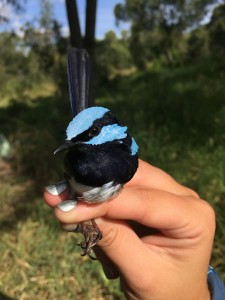
The habitats we visit are jaw-dropping and teeming with brightly colored life forms, be they flocks of rainbow parakeets crowding the trees over our campsite as we wake up, or bee-eaters flying overhead as we look out at the Pacific Ocean from a sand blowout, one of the most incredible vistas I’ve seen. The people I’ve met have outrageous stories, because life here is an adventure, as my future blog posts will reveal. It’s really interesting to me to feel my mind trying to make sense of where I am—I’m trying to relate what I’m experiencing to similar experiences I’ve already had, but what I’m experiencing is so new. This means keeping an open mind, and it means that I find myself marveling at almost everything I encounter. I’m experiencing my first true field season and discovering what field research and researchers are like, while trying to take in as much of the culture and nature that surround me as I can. I’m constantly in awe, which is a pretty exciting way to spend a summer.
